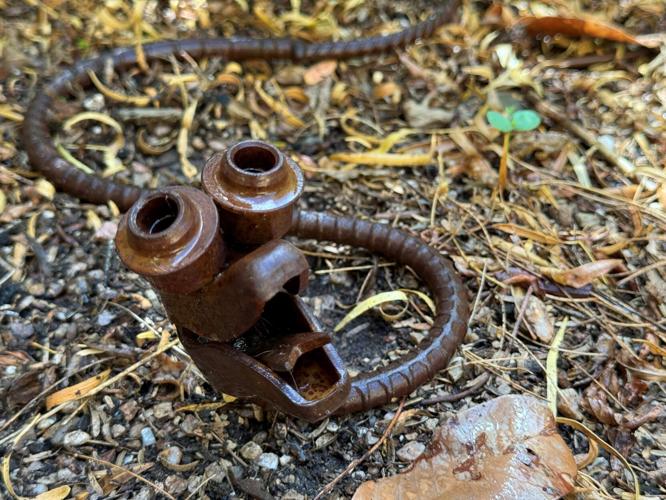We like to use our gardens not just for growing plants but to give us a beautiful space to enjoy the outdoors. Gardeners like to decorate their spaces just like we decorate our homes. Decorations make the space seem more personal, and add a human dimension to our outdoor areas.
In the Tucson desert, choosing our decorations wisely is key. Our harsh sun, sometimes torrential rain and occasional high winds make decorating a challenge. There are some materials that simply don’t work in our climate. But there are still a lot of materials we can use.
For example, glass is a great material for the garden. Whether you want to put in a gazing ball, hang decorative glass sculptures, or put in attractive glass accents, glass decorations in a garden can add color and sparkle. Mirrors are another great decorating item for gardens. Not only do they reflect light, they can give the illusion of a second garden beyond a wall.
Steel and other metals also can be used to create focal points in a garden, or can be used for privacy screens or even to provide shade. Sculptures such as animals made of metal can add an interesting feature to your garden. Laser-cut steel panels give shade or privacy while providing an artistic touch. If you’re shopping online for these, make sure the panels you’re buying are actually made of metal, as many manufacturers are also selling less expensive plastic composite panels. These will not hold up in our sun. Windmills can also provide some movement to your space.

Metal sculptures like this small snake can add a bit of dimension and whimsy to your garden.
Concrete and stone are also great possibilities for decorating materials. From fountains to columns to paths and garden borders, these materials provide an opportunity to put in some texture and shape into your garden. You can read more about garden path options in my article “Garden paths in the desert.”
Ceramics can also provide us with color. Decorative talavera planters and sculptural animals are a great addition to a garden and can provide some whimsy. Other types of ceramic planters as well as birdbaths can also bring in color and glossiness.

This talavera turtle has some personality and color and is a cute addition to a garden.
Also, don’t forget about something very simple and basic: paint. You can choose unusual colors for your wall or house, create accent walls, paint planting areas, or paint old furniture. Paint obviously has a limited lifespan in our climate, but it’s not very expensive and is a great way to add some dimension and interest. Choose paint that is rated for outdoor use if possible.
Fabrics help to give our garden spaces texture and coziness, but you need to choose them with care. Sunbrella fabrics tend to do well in our climate, and many sellers give you the option to search their catalogs by brand. If you don’t have the budget for Sunbrella fabrics, I recommend you stick to smaller items (small cushions for your deck chairs, for example) so that you can replace them easily when they inevitably fall apart.
Your shade structures can also be part of your decoration. Pergolas, gazebos and other shade structures can add to the feeling that your outdoor space is a room. You can add decorative touches to the structures, and fabrics can add color, texture and coziness. For more information about shade structures, check out my article “Shade structures for your Tucson garden.”
Lights are another great decorative item for your yard. These have the double benefit of making outdoor spaces safer and more pleasant in the nighttime. String lights, accent lights and pathway lights are just some of the types of lighting you can use to give your garden more dimension even after dark. For more about choosing lighting for your garden, take a look at my article “Outdoor lighting for your Tucson home.”

Metal lizards crawling up a garden wall add color and personality.
There are some decorative items that don’t work well in our climate. I recommend staying away from plastic, as it will fade and fall apart in our sun. Exceptions to this are certain items (like these large plant pots) which are rated to be UV stable.
While I adore planting walls, I have yet to find one that would work for our desert climate. Unfortunately these tend to have very small integral planters, which will dry up within a couple of hours in our dry air and hot sun. Many have planters made of cloth, which are even worse. Even our native cacti need more soil and moisture to thrive and grow. Succulents that are hung in succulent walls generally need to be put in shade or part shade, and are not likely to make it in a hot patio in our climate. They will need watering at least once a day, which isn’t practical.
Similarly, stay away from small planters, like cute animal-shaped ones or matching sets of small pots. You can use these indoors if you have already purchased them, but they will not work outside.
Finally, use your judgment when using wood. I would avoid using it as a fencing material, for instance, since a large fenced-in area would be expensive and you don’t want to replace it in 10 years. You can use it for planters, but keep in mind that it won’t last too long. It may be possible to extend the life of wood in our climate with careful maintenance with UV-resistant finishes, but I recommend gravel, bricks, stone or tile for patios. For fencing I recommend metal or stucco if your budget allows. For more ideas on fencing, check out my article “Choosing a fence for your Tucson yard”.
Inspiration on how to use desert-adapted plants in a formal garden design in the Tucson desert. Video by Dominika Heusinkveld/Arizona Daily Star







